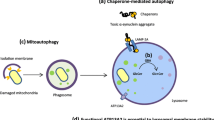Abstract
Parkinson’s disease (PD) is characterised both clinically and pathologically by features that distinguish it from other parkinsonian disorders including, for instance, multiple system atrophy and progressive supranuclear palsy. The aetiologies of PD includes both genetic and environmental influences. Several single gene causes of autosomal dominant and recessive PD have been described. Recent genome-wide association (GWA) studies have identified a number of risk alleles for PD. No specific environmental cause has been defined but several factors have been described which influence the risk for PD. Mitochondrial dysfunction, free radical mediated damage, inflammatory change and proteasomal dysfunction have been thought to play a role in PD pathogenesis. Autophagy is now recognised as an important component of the cell’s mechanism for protein turnover and has relevance for PD. There is some convergence and overlap of pathogenetic pathways between environmental and genetic factors. The importance of identifying the molecular and biochemical events that lead to PD lies in the prospect that novel drug targets will emerge and that new compounds will be developed that slow the progression of the disease.
Similar content being viewed by others
Further reading
Alvarez-Erviti L, Rodriguez-Oroz MC, Cooper JM, Caballero C, Ferrer I, Obeso JA et al (2010) Chaperone-mediated autophagy markers in Parkinson disease brains. Arch Neurol 67(12):1464–1472
Dexter DT et al (1994) Indices of oxidative stress and mitochondrial function in individuals with incidental Lewy body disease. Ann Neurol 35:38–44
Gandhi S et al (2009) PINK1-associated Parkinson’s disease is caused by neuronal vulnerability to calcium-induced cell death. Mol Cell 33:627–638
Gasser T (2009) Genomic and proteomic biomarkers for Parkinson disease. Neurology 72:S27–S31
Gegg ME, Cooper JM, Schapira AH, Taanman JW (2009) Silencing of PINK1 expression affects mitochondrial DNA and oxidative phosphorylation in dopaminergic cells. PLoS One 4:e4756
Grunewald A et al (2009) Differential effects of PINK1 nonsense and missense mutations on mitochondrial function and morphology. Exp Neurol 219:266–273
Gupta A, Dawson VL, Dawson TM (2008) What causes cell death in Parkinson’s disease? Ann Neurol 64:S3–S15
Hart RG, Pearce LA, Ravina BM, Yaltho TC, Marler JR (2009) Neuroprotection trials in Parkinson’s disease: systematic review. Mov Disord 24:647–654
Healy DG et al (2008) Phenotype, genotype, and worldwide genetic penetrance of LRRK2-associated Parkinson’s disease: a case–control study. Lancet Neurol 7:583–590
Hirsch EC, Hunot S (2009) Neuroinflammation in Parkinson’s disease: a target for neuroprotection? Lancet Neurol 8:382–397
Martinez-Vicente M, Cuervo AM (2007) Autophagy and neurodegeneration: when the cleaning crew goes on strike. Lancet Neurol 6:352–361
Morais VA et al (2009) Parkinson’s disease mutations in PINK1 result in decreased Complex I activity and deficient synaptic function. EMBO Mol Med 1:99–111
Narendra D, Tanaka A, Suen DF, Youle RJ (2008) Parkin is recruited selectively to impaired mitochondria and promotes their autophagy. J Cell Biol 183:795–803
Olanow CW, Kieburtz K, Schapira AH (2008) Why have we failed to achieve neuroprotection in Parkinson’s disease? Ann.Neurol 64:S101–S110
Pan T, Kondo S, Le W, Jankovic J (2008) The role of autophagy-lysosome pathway in neurodegeneration associated with Parkinson’s disease. Brain 131:1969–1978
Rubinsztein DC (2006) The roles of intracellular protein-degradation pathways in neurodegeneration. Nature 443:780–786
Schapira AH (1999) Science, medicine, and the future: Parkinson’s disease. BMJ 318:311–314
Schapira AH (2006) Etiology of Parkinson’s disease. Neurology 66:S10–S23
Schapira AH (2008) Mitochondria in the aetiology and pathogenesis of Parkinson’s disease. Lancet Neurol 7:97–109
Schapira AH (2009a) Neurobiology and treatment of Parkinson’s disease. Trends Pharmacol Sci 30:41–47
Schapira AH (2009b) Molecular and clinical pathways to neuroprotection of dopaminergic drugs in Parkinson disease. Neurology 72:S44–S50
Schapira AH et al (1989) Mitochondrial complex I deficiency in Parkinson’s disease. Lancet 1:1269
Schapira AH et al (2009) Perspectives on recent advances in the understanding and treatment of Parkinson’s disease. Eur J Neurol 16:1090–1099
Sidrasky et al (2009) Multicenter analysis of glucocerebrosidase mutations in Parkinson’s disease. N Engl J Med 361:1651–1661
Warner TT, Schapira AH (2003) Genetic and environmental factors in the cause of Parkinson’s disease. Ann Neurol 53(Suppl 3):S16–S23
Conflict of interest
The author reports no conflict of interest.
Author information
Authors and Affiliations
Corresponding author
Additional information
This article is part of a supplement sponsored by GlaxoSmithKline.
Rights and permissions
About this article
Cite this article
Schapira, A.H.V. Aetiopathogenesis of Parkinson’s disease. J Neurol 258 (Suppl 2), 307–310 (2011). https://doi.org/10.1007/s00415-011-6016-y
Published:
Issue Date:
DOI: https://doi.org/10.1007/s00415-011-6016-y




